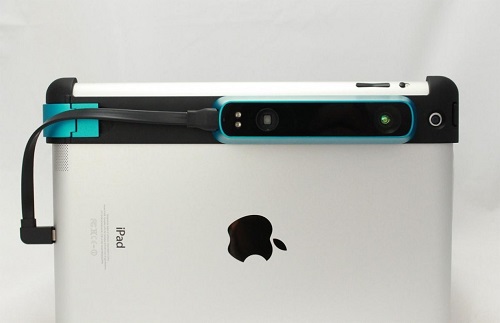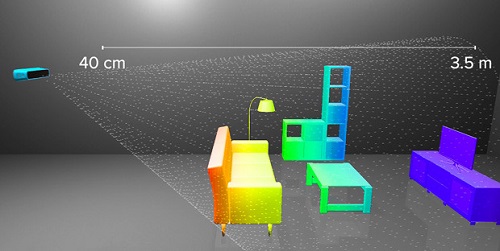Mentioning the term “camera-phone” to anyone in the 1990s should have invoked confusing mental images of massive handheld cameras duct-taped to equally massive walkie-talkie-looking cell phones. By contrast, the phrase “3D-scanner-phone” is much more plausible in 2013; it’s the next step-up from camera-phones and within the realm of possibility in the near future. The Structure Sensor is the world’s first portable, clippable, and hackable 3D scanner, bridging the gap between what’s missing in contemporary smartphones and what will become standard. And you bet there’s a demand for this sort of thing ― the Structure Sensor surpassed its Kickstarter campaign goal within the first three hours and reached 690% of its goal within the first week.
Size and shape
Structure Sensor was designed with mobility and ease-of-access in mind. For that reason, attaching it to a fourth-generation iPad or other mobile device is as easy as clipping the mounting brace. The device is sleek and compact, measuring approximately 11.9 x 2.8 x 2.9 cm. A chassis machined out a single piece of high-grade anodized aluminum grants a distinct high-end finish.

Image processing happens in the connected mobile device.
Range and scan-ability
Structure Sensor uses a full-sized PrimeSense Carmine sensor to perform real-time scans within an optimal range of 40 cm to 3.5 m. The subsequent image processing occurs in the mobile device connected to the Structure Sensor, allowing full benefit of advancing hardware. According to chief computer vision engineer at Occipital, the firm designing the Structure Sensor, a 10-second wait period is needed to transform scans into meshes suitable for 3D printing with all the colors included. This is a very small price to pay considering the amount of time saved by having a printable 3D mesh assembled for you.

For anyone wondering whether the quality of scans is actually worth its weight in salt, the Structure Sensor renders a human head scan at 77,000 polygons. If needed, this size can be reduced using 3D imagine software such as Skanect.
Additionally, a dual set of infrared LEDs grants the Structure Sensor night vision. The included software development kit grants full control over the IR LEDs to allow nifty augmented reality apps infused with night vision; haunted house app, anyone?
Compatibility
Securely attaching the Structure Sensor to an iPad requires the use of mounting brackets, and backers of the Structure Sensor will have the opportunity to select a mounting bracket specific to their iPad generation beginning with the fourth generation. Occipital promises to officially support future incarnations of the tablet with updated brackets.
Due to the large amount of variation between Android phones, attachment brackets are not officially produced. As a remedy of sorts, Occipital provides an open 3D CAD model of a starter bracket to grant users the option of designing their own brackets. In essence, with a bit of work the Structure Sensor can be attached to anything. More importantly, the sensor interfaces with any platform able to support USB.
Software developer kit
Each Structure Sensor comes with a series of free demo applications to help users get acquainted with all of the features. This includes an object scanner app for capturing and exporting 3D models to CAD, a room scanner to replicate the 3D model of an enclosed space, and an augmented reality fetch and ball physics mini-game.
While the first two apps are certainly impressive and standalone, Occipital wants to encourage users to take apart the source code and use the API to create their own apps. With such advanced technology seemingly condensed into a light portable gadget, a slew of apps that interact with the environment in new ways will inevitably pop up. Just consider the practicality of an interior design app that determines how and if a new piece of furniture will fit in your home before ever purchasing it, or how specific paint colors affect your Zen balance.
Unfortunately, the only glaring flaw to this entire philosophy is the omission of Android and other operating systems from the demo apps; they’re iOS exclusive. Occipital has no plans to release its featured apps and demos for any platform outside of iOS although open source drivers will be provided for Windows, Android, OS X and Linux, making developers in these operating systems work a bit harder.
Visit Structure Sensor’s official Kickstarter page to procure your own unit.
Advertisement
Learn more about Electronic Products Magazine





